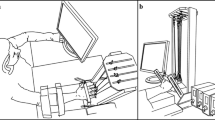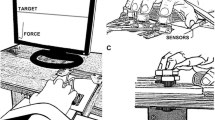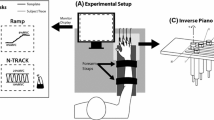Abstract
Prior research has concluded that the correlations of isometric finger forces represent the extent to which the fingers are controlled as a single unit. If this is the case, finger force correlations should be consistent with estimates of the controlled (dynamical) degrees of freedom in finger forces. The present study examined the finger force correlations and the dynamical degrees of freedom in four isometric force tasks. The tasks were to produce a preferred level of force with the (a) Index, (b) Ring, (c) Both fingers and also to (d) Rest the fingers on the load cells. Dynamical degrees of freedom in finger forces were lowest in the Both finger force task and progressively higher in the Ring, Index and Resting finger force tasks. The finger force correlations were highest in the Resting and lowest in the Index and Ring finger tasks. The results for the dynamical degrees of freedom in finger forces were consistent with a reduction in degrees of freedom in response to the degrees of freedom problem and the task constraints. The results for the finger force correlations were inconsistent with a reduction in the dynamical degrees of freedom. These findings indicate that finger force correlations do not necessarily reflect the coupling of finger forces. The findings also highlight the value of time-domain analyses to reveal the organization of control in isometric finger forces.




Similar content being viewed by others
References
Bernstein N (1967) The coordination and regulation of movements. Pergamon Press, New York
Fahrer M (1981) Interdependent and independent actions of the fingers. In: Tubiana R (ed) The hand. Saunders, Philadelphia, pp 399–401
Goodman L, Riley MA, Mitra S, Turvey MT (2000) Advantages of rhythmic movements at resonance: minimal active degrees of freedom, minimal noise, and maximal predictability. J Mot Behav 32:3–8
Gorniak SL, Zatsiorsky VM, Latash ML (2011) Manipulation of a fragile object by elderly individuals. Exp Brain Res 212:505–516
Hong SL, Newell KM (2008a) Entropy compensation in human motor adaptation. Chaos 18:013108
Hong SL, Newell KM (2008b) Entropy conservation in the control of human action. Nonlinear Dyn Psychol Life Sci 12:163–190
Hong SL, Lee MH, Newell KM (2007) Magnitude and structure of isometric force variability: mechanical and neurophysiological influences. Mot Control 11:119–135
Hong SL, Brown AJ, Newell KM (2008) Compensatory properties of visual information in the control of isometric force. Percept Psychophys 70:306–313
Jordan K, Challis JH, Newell KM (2007) Walking speed influences on gait cycle variability. Gait Posture 26:128–134
Kelso JAS (1995) Dynamic patterns. MIT Press, Cambridge
Keogh J, Morrison S, Barrett R (2006) Age-related differences in inter-digit coupling during finger pinching. Eur J Appl Physiol 97:76–88
Kilbreath SL, Gandevia SC (1994) Limited independent flexion of the thumb and fingers in human subjects. J Physiol 479:487–497
Kim SW, Shim JK, Zatsiorsky VM, Latash ML (2008) Finger inter-dependence: linking the kinetic and kinematic variables. Hum Mov Sci 27:408–422
Kugler PN, Turvey MT (1987) Information, natural law, and the self-assembly of rhythmic movement. Lawrence Erlbaum, Hillsdale NJ
Kugler PN, Kelso JAS, Turvey MT (1980) On the concept of coordinative structures as dissipative structures: 1. Theoretical lines of convergence. In: Stelmach GE, Requin J (eds) Tutorials in motor behavior. North-Holland, Amsterdam, pp 3–47
Kugler PN, Kelso JAS, Turvey MT (1982) On the control and coordination of naturally developing systems. In: Kelso JAS, Clark JE (eds) The development of movement control and coordination. Wiley, New York, pp 5–78
Kutner MH, Nachtesheim CJ, Neter J, Li W (2005) Applied linear statistical models. McGraw-Hill, New York
Latash ML, Li ZM, Zatsiorsky VM (1998) A principle of error compensation studied within a task of force production by a redundant set of fingers. Exp Brain Res 122:131–138
Latash ML, Scholz JF, Schöner G (2007) Toward a new theory of motor synergies. Mot Control 11:276–308
Leijnse JNAL (1997) Measuring force transfers in the deep flexors of the musician’s hand: theoretical analysis, clinical examples. J Biomech 30:873–882
Leijnse JN, Snijders CJ, Bonte JE, Landsmeer JM, Kalker JJ, Van der Meulen JC, Sonneveld GJ, Hovius SE (1993) The hand of the musician: the kinematics of the bidigital finger system with anatomical restrictions. J Biomech 26:1169–1179
Maier MA, Hepp-Reymond M-C (1995) EMG activation patterns during force production in precision grip: II. Muscular synergies in the spatial and temporal domain. Exp Brain Res 131:101–110
Martin JR, Latash ML, Zatsiorsky VM (2009) Interaction of finger enslaving and error compensation in multiple finger force production. Exp Brain Res 192:293–298
Martin JR, Zatsiorsky VM, Latash ML (2011) Multi-finger interaction during involuntary and voluntary single finger force changes. Exp Brain Res 208:423–435
Mitra S, Amazeen PG, Turvey MT (1998) Intermediate motor learning as decreasing active (dynamical) degrees of freedom. Hum Mov Sci 17:17–65
Moerchen VA, Lazarus JC, Gruben KG (2007) Task-dependent organization of pinch grip forces. Exp Brain Res 180:367–376
Newell KM (1986) Constraints on the development of coordination. In: Wade MG, Whiting HTA (eds) Motor development in children: aspects of coordination and control. Martinus Nijhoff Publishers, Amsterdam
Newell KM, Broderick MP, Deutsch KM, Slifkin AM (2003) Task goals and change in dynamical degrees of freedom with motor learning. J Exp Psychol Hum Percept Perform 29:379–387
Olafsdottir HB, Zatsiorsky VM, Latash ML (2008) The effects of strength training on finger strength and hand dexterity in healthy elderly individuals. J Appl Physiol 105:1166–1178
Pincus S, Singer BH (1996) Randomness and degrees of irregularity. Proc Nat Acad Sci 93:2083–2088
Ranganathan R, Newell KM (2008) Motor synergies: feedback and error compensation within and between trials. Exp Brain Res 186:561–570
Sanes JN, Donoghue JP, Thangaraj V, Edelman RR, Warach S (1995) Shared neural substrates controlling hand movements in human motor cortex. Science 268:1775–1777
Schieber MH, Hibbard LS (1993) How somatotopic is the motor cortex area. Science 261:489–492
Schuind F, Garcia-Elias M, Cooney WP, An KN (1992) Flexor tendon forces: in vivo measurements. J Hand Surg [Am] 17:291–298
Sharp WE, Newell KM (2000) Coordination of grip configuration as a function of force output. J Mot Behav 32:73–82
Slifkin AB, Newell KM (1999) Noise, information transmission, and force variability. J Exp Psychol Hum Percept Perform 25:837–851
Sosnoff JJ, Jordan K, Newell KM (2005) Information and force level interact in regulating force output during two and three digit grip configuration. Exp Brain Res 167:76–85
Sosnoff JJ, Valantine AD, Newell KM (2006) Independence between the amount and structure of variability at low force levels. Neurosci Lett 392:165–169
Stergiou N (2004) Innovative analysis of human movement. Human Kinetics, Champaign IL
Turvey MT (1977) Preliminaries to a theory of action with reference to vision. In: Shaw R, Bransford J (eds) Perceiving, acting and knowing: toward an ecological psychology. Lawrence Erlbaum, Hillsdale, pp 211–265
Turvey MT (2007) Action and perception at the level of synergies. Hum Mov Sci 26:657–697
Vaillancourt DE, Slifkin AB, Newell KM (2001) Regularity of force tremor in Parkinson's disease. Clin Neurophysiol 112:1594–1603
Vaillancourt DE, Slifkin AB, Newell KM (2002) Inter-digit individuation and force variability in the precision grip of young, elderly, and Parkinson’s disease participants. Mot Control 6:113–128
Zatsiorsky VM, Latash ML (2004) Prehension synergies. Exerc Sport Sci Rev 32:75–80
Zatsiorsky VM, Li ZM, Latash ML (1998) Coordinated force production in multi-finger tasks: finger interaction and neural network modeling. Biol Cybern 79:139–150
Zatsiorsky VM, Li ZM, Latash ML (2000) Enslaving effects in multi-finger force production. Exp Brain Res 131:187–195
Author information
Authors and Affiliations
Corresponding author
Rights and permissions
About this article
Cite this article
James, E.G. Dynamical degrees of freedom and correlations in isometric finger force production. Exp Brain Res 223, 533–539 (2012). https://doi.org/10.1007/s00221-012-3280-8
Received:
Accepted:
Published:
Issue Date:
DOI: https://doi.org/10.1007/s00221-012-3280-8




